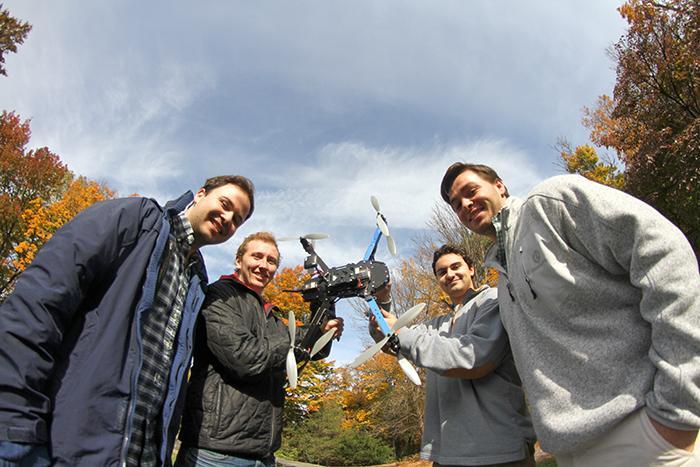Drones seem to be everywhere these days. They are used to deliver packages, inspect bridges and power lines, and help with disaster relief.
And if an innovative project by a group of students and professors in economics and engineering gets off the ground, drones, or unmanned aerial vehicles, will one day be able to tackle a task not for the faint of heart: washing the windows of high-rises and other tall buildings.
“This is a unique opportunity for interdisciplinary collaboration with a technology that continues to evolve,” said Hal Fried, the David L. '39 and Beverly B. Yunich Professor of Business Ethics.
Fried and David Hodgson, associate professor and chair of mechanical engineering, launched the project through their association with Chris Kitts, associate dean of research and faculty development, School of Engineering, Santa Clara University. A robotics expert, Kitts received a grant from KEEN (The Kern Entrepreneurship Education Network) to explore possible uses for UAVs. Keen supports projects to encourage the entrepreneurial mindset in engineering education including cross-disciplinary connections that spur creativity and value creation.
Kitts donated a UAV worth $2,000 to Union. Fried and Hodgson, along with William Keat, professor of mechanical engineering, recruited four seniors: Steven Nadel and Spencer Fontein (Mechanical Engineering); and Jake Concavage and Ben Willis (Economics). For the economics students, the project serves as their senior thesis. For the mechanical engineering students, it serves as their senior project.
“It’s very interesting to explore a topic that is so new, controversial and has the potential to change not only the way we wage war, but the way we do business and connect with others,” Willis said.
Nadel and Fontein often brainstorm ideas. When they were asked to design a working prototype of an application using a UAV for a business, the pair settled on the window-washing concept.
They face significant engineering challenges, including sideways delivery, or how to mount a window-washing device to the drone without affecting its ability to fly.
“Sideways delivery refers to delivering a payload horizontally outside the envelope of the UAVs rotors rather than delivering the payload vertically directly below the UAV,” said Hodgson. “The students will have to design a system that compensates appropriately as the payload is extended. To do that, they will need to apply the fundamental engineering modeling and design techniques that they have learned over the past three years.”
As economic majors, Concavage and Willis investigated the complex array of regulatory rules that govern the use of drones. They also researched the history of drones, which were virtually unheard of five years ago.
Next, they plan to reach out to local businesses to gauge their interest in the commercial use of drones. They will produce a business plan for a drone services company in Schenectady.
Drone technology is big business. A recent industry report noted that investments in drone technology the first five months of this year reached $172 million — more than the total from the previous five years combined. While venture capital investments accounted for most of the money, companies such as GE, Qualcomm and Intel also are involved.
One challenge the students encountered from the start was finding space to fly legally. They had one quick test flight outdoors, but Federal Aviation Administration (FAA) regulations require them to file paperwork and register their aircraft before they are granted permission to fly outside.
For now, any test flights will be limited to Memorial Fieldhouse.
While a window-washing drone isn’t imminent, the students have enjoyed working together on one of the hottest technologies.
“Drones have the potential to aid society and even save lives,” Nadel said. “Once FAA regulations become suitable for drone applications, the possibilities are endless.”
